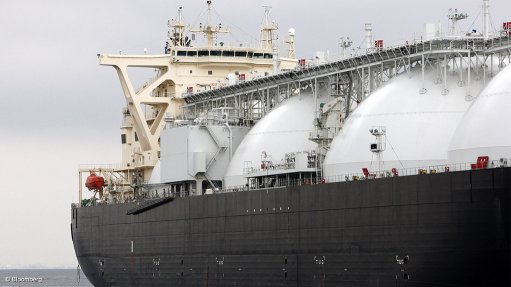
Photo by: Bloomberg
PERTH (miningweekly.com) – Despite mounting political and trade tensions between Australia and China, Australia’s liquefied natural gas (LNG) shipments to the Asian giant have remained unaffected, data from energy advisory EnergyQuest has shown.
EnergyQuest has reported that in the first ten months of 2020, Australia delivered 23.5-million tonnes of LNG to China, which was on par with the first ten months of 2019.
China’s LNG imports from Australia reached 2.3-million tonnes in September, with EnergyQuest estimating that imports in October reached some 2.2-million tonnes, marginally higher than the same period in 2019.
“Australia remains far and away the largest LNG supplier to China, accounting for 40% of Chinese imports in September, four times the imports from the next biggest suppliers, Qatar, Indonesia and Malaysia, which each have a market share of around 10%. Australia is also a larger supplier than any of the central Asian suppliers of pipeline gas,” EnergyQuest’s latest report read.
All Australian LNG projects export to China, however around half of the exports to China come from the three Gladstone projects.
Gladstone Ports data shows east coast exports to China were 1.2-million tonnes in October, accounting for some 60% of total exports, the same as in September and only 0.2-million tonnes less than the east coast exports seen in October 2019.
China is still the largest export destination for east coast LNG, and for the first ten months of 2020, 70% of east coast LNG, or some 12-million tonnes, has been exported to China, compared with 13.2-million tonnes in the same period in 2019.
EnergyQuest pointed out that China is heavily invested in Queensland LNG, with China’s State-run CNOOC, PetroChina and Sinopec all invested in Queensland gas projects.
Total Chinese LNG imports have grown strongly, despite the pandemic. Imports for the first nine months of 2020 were 48.2-million tonnes, up from the 43.7-million in the corresponding period in 2019. Each month of 2020 has been higher than the corresponding month of 2019, the energy advisory pointed out.
Meanwhile, Japan remains Australia’s largest LNG customer, importing some 54.7-million tonnes in the first nine months of the year, compared with the 48.1-million tonnes of Australian LNG imported by China.
EnergyQuest noted that in the year to October Australia delivered 24.3-million tonnes to Japan compared with 23.5-million tonnes to China. However, Japanese volumes were 5% lower than in the previous year.